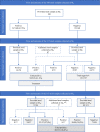Epidemiology of soil-transmitted helminth infections and the differential effect of treatment on the distribution of helminth species in rural areas of Gabon
- PMID: 38163912
- PMCID: PMC10759385
- DOI: 10.1186/s41182-023-00567-z
Epidemiology of soil-transmitted helminth infections and the differential effect of treatment on the distribution of helminth species in rural areas of Gabon
Abstract
Background: Soil-transmitted helminth (STH) infections are a public health concern in endemic areas. For efficient control, the epidemiology of the disease needs to be monitored. This report assesses the prevalence, incidence, post-treatment infection (PTI) rate, and risk factors for STH infections in two rural areas of Gabon.
Method: In this longitudinal and prospective study, participants aged six to 30 years from the vicinity of Lambaréné and selected households using a simple randomization process were included and followed in two consecutive periods of six and nine months. Stool samples were obtained at the beginning and the end of each follow-up phase (FUP). The Kato-Katz technique was used for the detection of STH eggs, while the Harada-Mori technique and coproculture were used for the detection of larvae in stool processed within a maximum of four hours of collection. Prevalence was determined at the three main time points of the study, incidence was assessed during the two study phases, and PTI was defined as an infection detected nine months post-treatment.
Results: A total of 262 participants were included. The overall prevalence of STH infections was 42% (95%CI: 34-50) and 44% (95%CI: 37-51) at baseline for the six and nine month FUPs, respectively. Trichuris trichiura was the most prevalent species at each time point of assessment. The cumulative incidence of STH at the 6- and 9-month follow-ups was 18% (95%CI: 12-27) and 35% (95%CI: 27-43), respectively, while the incidence rates were 41 (95%CI: 28-55) and 56 (95%CI: 46-67) per 100 person-years, respectively. The PTI rates at the 9-month follow-up for T. trichiura, hookworm, and Ascaris lumbricoides were 58% (95%CI: 41-74), 31% (95%CI: 11-59) and 18% (95%CI: 5-40), respectively. The STH infection intensity was generally light.
Conclusion: The prevalence level of STH infection is moderate in the vicinity of Lambaréné, with T. trichiura being the most prevalent species. Our results reveal a rapid spread of the disease in the population mainly following intervention, particularly for trichuriasis, and therefore call for the full implementation of the World Health Organization's recommendations in the area. Trial registration clinicaltrials.gov Identifier NCT02769013. Registered 21 April 2016, https://clinicaltrials.gov/study/NCT02769013.
Keywords: Anthelminthic treatment; Ascaris lumbricoides; Epidemiology; Gabon; Hookworm; Incidence; Prevalence; Trichuris trichiura.
© 2023. The Author(s).
Conflict of interest statement
The authors declare that they have no competing interests.
Figures
Similar articles
-
Fine mapping of Ascaris lumbricoides, Trichuris trichiura and hookworm infections in sub-districts of Makenene in Centre Region of Cameroun.Sci Rep. 2022 Aug 17;12(1):13935. doi: 10.1038/s41598-022-18285-7. Sci Rep. 2022. PMID: 35978014 Free PMC article.
-
Epidemiology of Schistosomiasis and Soil-Transmitted Helminth Coinfections among Schoolchildren Living in Lambaréné, Gabon.Am J Trop Med Hyg. 2020 Jul;103(1):325-333. doi: 10.4269/ajtmh.19-0835. Epub 2020 May 14. Am J Trop Med Hyg. 2020. PMID: 32431272 Free PMC article.
-
Factors associated with soil-transmitted helminths infection in Benin: Findings from the DeWorm3 study.PLoS Negl Trop Dis. 2021 Aug 17;15(8):e0009646. doi: 10.1371/journal.pntd.0009646. eCollection 2021 Aug. PLoS Negl Trop Dis. 2021. PMID: 34403424 Free PMC article. Clinical Trial.
-
Soil-transmitted helminth infection in school age children in Sierra Leone after a decade of preventive chemotherapy interventions.Infect Dis Poverty. 2019 Jul 2;8(1):41. doi: 10.1186/s40249-019-0553-5. Infect Dis Poverty. 2019. PMID: 31262367 Free PMC article.
-
Efficacy of triple dose albendazole treatment for soil-transmitted helminth infections.PLoS One. 2022 Aug 12;17(8):e0272821. doi: 10.1371/journal.pone.0272821. eCollection 2022. PLoS One. 2022. PMID: 35960935 Free PMC article.
Cited by
-
Performance of real-time polymerase chain reaction and Kato-Katz for diagnosing soil-transmitted helminth infections and evaluating treatment efficacy of emodepside in randomized controlled trials.PLoS Negl Trop Dis. 2025 Feb 18;19(2):e0012872. doi: 10.1371/journal.pntd.0012872. eCollection 2025 Feb. PLoS Negl Trop Dis. 2025. PMID: 39965016 Free PMC article. Clinical Trial.
-
Iron homeostasis and cytokine responses in Gabonese children with febrile illness.Commun Med (Lond). 2025 Jul 22;5(1):305. doi: 10.1038/s43856-025-00988-3. Commun Med (Lond). 2025. PMID: 40696137 Free PMC article.
-
Co-morbidity of malaria and soil-transmitted helminths in Nigeria: a joint Bayesian modelling approach.Infect Dis Poverty. 2025 Apr 2;14(1):28. doi: 10.1186/s40249-025-01276-x. Infect Dis Poverty. 2025. PMID: 40170071 Free PMC article.
References
-
- World Health Organization. https://apps.who.int/neglected_diseases/ntddata/sth/sth.html. Accessed 20 July 2020.
-
- Organization WH. Soil-transmitted helminthiases: eliminating as public health problem soil-transmitted helminthiases in children : progress report 2001–2010 and strategic plan 2011–2020. World Health Organization; 2012. https://apps.who.int/iris/handle/10665/44804. Accessed 20 July 2020.
-
- Partners for Parasite Control. Meeting (3rd: 2004 : Geneva S, Team WHOSD and M for PD and VC. Deworming for health and development : report of the third global meeting of the partners for parasite control. 2005. https://apps.who.int/iris/handle/10665/69005. Accessed 20 July 2020.
-
- Adegnika AA, Zinsou JF, Issifou S, Ateba-Ngoa U, Kassa RF, Feugap EN, et al. Randomized, controlled, assessor-blind clinical trial to assess the efficacy of single- versus repeated-dose albendazole to treat ascaris lumbricoides, Trichuris trichiura, and hookworm infection. Antimicrob Agents Chemother. 2014;58(5):2535–2540. doi: 10.1128/AAC.01317-13. - DOI - PMC - PubMed
Associated data
Grants and funding
LinkOut - more resources
Full Text Sources
Medical
Miscellaneous


